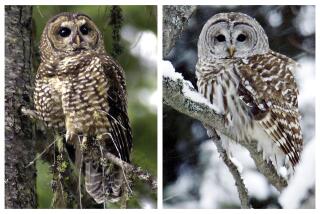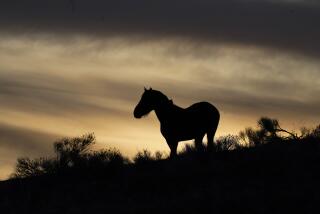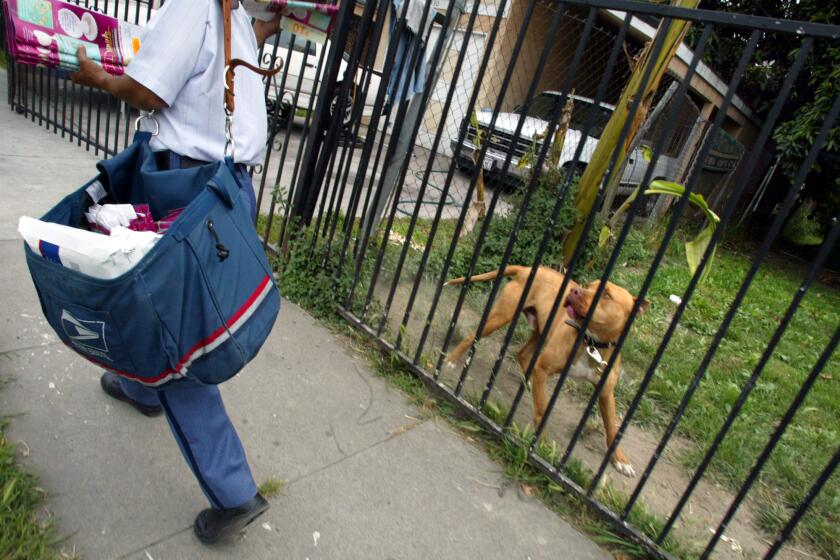A Novel Idea to Tame Numbers of Wild Horses
- Share via
LOVELL, Wyo.--For Linda Coates-Markle, watching the young mares in the herd of wild horses that roam this region’s Pryor Mountain Range can be depressing.
Many are skinny and weak. Their foals, if they survive, are often sickly, perpetuating the unhealthy condition of their mothers.
It is why Coates-Markle and other federal land managers believe birth control for some wild horses in the West has become necessary.
“It seems to be a pretty humane alternative,” said Coates-Markle, who oversees the Bureau of Land Management’s wild horse and burro program in the area along the Wyoming-Montana border. “We want to give these mares a chance to grow up.”
For years, the BLM relied largely on roundups to remove wild horses from their Western range. Horses and burros were put up for adoption as a way to help control the population, estimated at 40,000 scattered throughout 10 Western states.
But the agency now believes birth control may provide another option--one that not only can help stabilize the population but also improve the health and genetic viability of the herds freely roaming some 34 million acres of public land.
Birth control has long been used to regulate animal populations in zoos and sometimes in the wild. But its expected use at the Pryor Mountain horse range and possibly other BLM-managed areas this year has made some animal rights activists nervous.
They’ve cited past problems with the BLM’s oversight of the horse adoption program, accusing the agency of turning a blind eye while some adopted horses were sent to slaughter.
They also criticize the agency’s announced goal of reducing the size of herds to achieve a better balance with environmental conditions, based on available forage and water.
“Their track record is not dramatically good,” said Alan Berger, executive director of the Animal Protection Institute.
Some also say birth control meddles with nature, while others worry about potential long-term effects on the behavior and size of wild horse herds.
“If the objective is to make sure the populations don’t continue to grow, that in and of itself is problematic in our eyes,” said Andrea Lococo of the Fund for Animals. The organization does not consider the wild horse population to be too large, and would prefer that the government leave the herds alone.
Officials hope to use the contraceptive vaccine as part of the agency’s population control effort for the first time this year. The contraceptive shots, meant to prevent pregnancy for a year, have been used previously on wild horses on federal land, but only in small tests, said Tom Pogacnik, senior wild horse and burro specialist for the BLM in Reno.
Meanwhile, the BLM is helping to fund development of another birth control vaccine that would last for two years. Trials of that drug are planned for this year.
The birth control vaccine causes the immune system to produce antibodies that block fertilization. Researchers say it is about 90% effective in delaying conception in treated mares, and they have seen no ill effects on the horses or environment.
“We’re looking to slow up reproduction, not stop it,” Pogacnik said. “It will slow down the rate of reproduction, meaning fewer roundups. All the way around, it’s a better thing for the horses.”
One of the sites where the vaccine has been used is Assateague Island National Seashore on the East Coast, where National Park Service managers had concerns with the health of wild horses and their range.
Using birth control, the island’s horse population stabilized over eight years and the age of the oldest horse also rose substantially.
“Their body condition improves. Their quality of life is better,” said Jay Kirkpatrick, part of the research team working with the contraceptive and overseeing its production at ZooMontana’s Science and Conservation Center, a research facility in Billings, Mont.
“There’s an immense frustration that we can’t get this applied in a broader way. Previous decisions by the BLM have nothing to do with this,” Kirkpatrick said. “There is no big plot to wipe out the West’s wild horse herds.”
Computer models have helped land managers predict effects on horse herds with or without administering birth control. They also have helped alleviate concerns that the population might crash, officials said.
Coates-Markle hopes to administer the vaccine to 22 mares among a 160-horse herd at the Pryor Mountain Range this summer.
“The public has expressed a great deal of concern over seeing these mares in poor shape and their babies in poor shape, and there really is no need for it,” Coates-Markle said.
In the last six years, about 20% of 2-year-old mares and 27% of 3-year-olds lost their foals, often because the animals were breeding too young, she said. In three cases, both the mare and foal died. Mares conceiving as yearlings or 2-year-olds may need a year or more to recuperate after giving birth, she said.
More to Read
Sign up for Essential California
The most important California stories and recommendations in your inbox every morning.
You may occasionally receive promotional content from the Los Angeles Times.













